|
|
|
Sort Order |
|
|
|
Items / Page
|
|
|
|
|
|
|
| Srl | Item |
| 1 |
ID:
133191
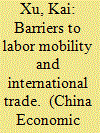

|
|
|
|
|
| Publication |
2014.
|
| Summary/Abstract |
This paper quantitatively evaluates the potential impacts of removing China's Hukou system on the world economy. By denying migrant workers the right to health benefits and housing, China's Household Registration (Hukou) system presents a significant distortion to the Chinese labor market that discourages the reallocation of its labor from agriculture to non-agriculture. I find that the elimination of Hukou could increase China's real income per capita by about 4.7%. Moreover, although for most countries the impact of removing Hukou is modest (less than 1% changes in real income per capita), substantial changes in real income could take place for China's small neighboring economies. For example, the decreases in real GDP per capita are 2.7%, 3.2%, and 4.1% for Bangladesh, Sri Lanka, and Vietnam, while Thailand stands to enjoy a 3.8% increase in its income.
|
|
|
|
|
|
|
|
|
|
|
|
|
|
|
|
| 2 |
ID:
133192
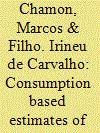

|
|
|
|
|
| Publication |
2014.
|
| Summary/Abstract |
This paper estimates the household income growth rates implied by food demand in a sample of urban Chinese households in 1993-2005. Our estimates, based on Engel curves for food consumption, indicate an average per capita income growth of 6.8% per year in 1993-2005. This figure is slightly larger than the 5.9% per year obtained by deflating nominal incomes by the CPI. We attribute this discrepancy to a small bias in the CPI, which is of a similar magnitude to the one often associated with the CPI in the United States. This result supports the view that Chinese price statistics are reliable. Our estimates indicate stronger gains among poorer households, suggesting that urban inflation up to 2005 in China was "pro-poor," in the sense that the increase in the cost of living for poorer households was smaller than for the average one.
|
|
|
|
|
|
|
|
|
|
|
|
|
|
|
|
| 3 |
ID:
133183


|
|
|
|
|
| Publication |
2014.
|
| Summary/Abstract |
This paper decomposes the growth of China's export into three parts: growth in extensive margin, increased quantity and increased prices; we perform a series of empirical analyses using China's export data at the HS-6 digit level to analyze the characteristics of China's export growth. China's export growth depends more and more on price increases, less and less on quantity expansion. Compared with the rest of world, China's export price is in the process of improving, not at an increasing speed but at a declining pace. China's export performance is better than the rest of the world after the financial crisis and in 2008-2010. This reflects a strategy of lowering price and promoting sales in 2009 when facing a slump in export markets; and resuming price increases and increasing sales moderately in reaction to improving export conditions in 2010.
|
|
|
|
|
|
|
|
|
|
|
|
|
|
|
|
| 4 |
ID:
133196
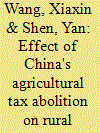

|
|
|
|
|
| Publication |
2014.
|
| Summary/Abstract |
This paper uses the rural household panel data collected by Research Center for Rural Economy to evaluate the impacts of China's agricultural tax abolition during 2004-2005 on farmers' income and production behavior. We find that the abolition of agricultural tax did not significantly affect agricultural production. The effects on input use and productivity are also found statistically insignificant. All these are consistent with the lump-sum property of the tax and imply little effect of the tax abolition on relaxing credit constraints to farmers. Finally, we find that the tax abolition did not increase farmers' net income significantly
|
|
|
|
|
|
|
|
|
|
|
|
|
|
|
|
| 5 |
ID:
133188


|
|
|
|
|
| Publication |
2014.
|
| Summary/Abstract |
The transformation of China into a Knowledge Based Economy is one of the most intensively debated research issues in Economic Geography. The focus of this study is on effects of knowledge capital on manufacturing total factor productivity (TFP) in China through the lens of the regional knowledge capital model (KCM). The objective is to estimate the impact of region-internal and region-external knowledge capital - measured in terms of patents granted by the Chinese patent office - on TFP across Chinese regions. We derive a Spatial Durbin Model (SDM) for empirical testing, using panel data on 29 Chinese regions for the years 1988-2007. The results indeed point to a shift of Chinese productivity growth to a more knowledge based one, statistically confirming the impact of knowledge capital on regional TFP after 1998. Furthermore, this shift is not only based on region-internal knowledge capital, but also on inter-regional knowledge spillovers.
|
|
|
|
|
|
|
|
|
|
|
|
|
|
|
|
| 6 |
ID:
133190
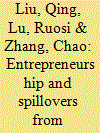

|
|
|
|
|
| Publication |
2014.
|
| Summary/Abstract |
Using nationwide survey data in China, we find evidence of positive FDI spillover effects via entrepreneurship. After controlling for a series of entrepreneur and firm attributes, our OLS estimates suggest that private firms run by entrepreneurs with MNE work experience outperform their counterparts run by entrepreneurs without MNE work experience. To deal with the potential endogeneity in the sense that inherently more capable entrepreneurs may self-select into MNEs before launching their own businesses, we use a nonparametric way, i.e., the propensity score matching (PSM) method, to identify the MNE "treatment" effect. The PSM estimates remain consistent with the OLS evidence, and the estimates are robust to different sensitivity analyses. We further find that private firms run by MNE-trained entrepreneurs do operate differently from their counterparts in both their global involvement and internal management, which are the underlying channels of the spillovers.
|
|
|
|
|
|
|
|
|
|
|
|
|
|
|
|
| 7 |
ID:
133194
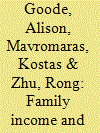

|
|
|
|
|
| Publication |
2014.
|
| Summary/Abstract |
We examine the effect of family income on child health using data from the China Health and Nutrition Survey. We find a significant child health/family income gradient for the overall sample of Chinese children. Our preferred specification shows that the income gradient increases with child age until the age of 12. We find that parental health consciousness, household sanitation conditions and nutrition intake are the channels through which family income affects child health. After controlling for these transmission channels, the gradient strengthens with child age until the age of 17. We find that children from poorer families in China are not only more likely to experience several types of chronic illnesses, but also less likely to address effectively some health conditions. The income gradient is found to be very heterogeneous, with greater effect on children with poorer health, girls and children in rural China.
|
|
|
|
|
|
|
|
|
|
|
|
|
|
|
|
| 8 |
ID:
133181
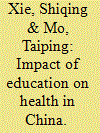

|
|
|
|
|
| Publication |
2014.
|
| Summary/Abstract |
In this paper, we investigate the causal effect of education on health using an instrumental variable approach. The instruments we employ consist of two institutional changes in China that generated discontinuities in educational attainment among individuals. To ensure the validity of the instruments and obtain prudent conclusions, we adopt more restrictive identification tests than previous studies. The results indicate no causal impact of education on either perceived health or anthropometric health. With regard to the impact of education on male health behavior, namely smoking, we cannot provide conclusive results due to a violation of the exogeneity of our instruments. Nevertheless, we can confirm that education has no causal effect on female health behavior. To overcome the widely documented shortage of quasi-experimental identification, we also employ spouse's education as an alternative instrument to examine the causal effect of education. Identical results are obtained, with the exception that the impact of education on the reduction of overweight among women becomes significant. We conclude that this provides some evidence of a causal impact of education on health.
|
|
|
|
|
|
|
|
|
|
|
|
|
|
|
|
| 9 |
ID:
133185
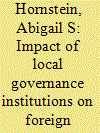

|
|
|
|
|
| Publication |
2014.
|
| Summary/Abstract |
This paper exploits the substantial variation in market institutions across provinces in China to examine the impact of institutional quality on foreign listing. Firms that are listed on the U.S. and U.K. exchanges are more likely to come from better regulated provinces and tend to be at the top of a corporate pyramid. However, though the impact on firm performance of market institutions and pyramidal affiliations persists briefly post-listing with firms recording lower EPS and higher raw returns in the first year, it does not help predict whether firms remain listed abroad in 2012. Thus, we conclude that headquarters' market institutions shape a firm through time of listing and have diminished influence over time.
|
|
|
|
|
|
|
|
|
|
|
|
|
|
|
|
| 10 |
ID:
133198
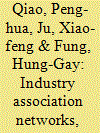

|
|
|
|
|
| Publication |
2014.
|
| Summary/Abstract |
This study uses panel data analysis to examine the effects of membership in industry association networks on innovation and firm performance in Chinese small and medium-sized enterprises (SMEs) listed on the Shenzhen Stock Exchange Small and Medium-size Enterprises Board from 2007 to 2011. There are several interesting findings. First, research and development (R&D) and technology staff have a positive and significant effect on innovation at SMEs. Second, participation in industry association networks (defined as comprising business association networks and technology association networks) can improve firm innovation at Chinese SMEs. Third, innovation is found to have a positive effect on firm performance at SMEs. Finally, membership in industry association networks can improve firm efficiency and increase non-operating income but at the expense of higher management costs at SMEs. Our study has important policy implications for policymakers and SMEs in China.
|
|
|
|
|
|
|
|
|
|
|
|
|
|
|
|
| 11 |
ID:
133195


|
|
|
|
|
| Publication |
2014.
|
| Summary/Abstract |
Export led growth has been very effective in modernising China's economy and establishing a large high-saving middle class. Notwithstanding political opposition from trading partners, this growth strategy has also offered the rest of the world improved terms of trade in both product and financial markets, in the form of cheaper light manufactures and cheaper credit. Yet slowing demand in export destinations has forced a transition to inward-sourced growth. This paper uses a numerical model of the Chinese economy with oligopoly behaviour to examine the available "inward" sources of transformative growth along with the policies needed to exploit them. The potential for further "transformative" growth is shown to be considerable though it will require accelerated skilled labour supply growth and the politically difficult extension of industry policy reform to heavy manufacturing and services
|
|
|
|
|
|
|
|
|
|
|
|
|
|
|
|
| 12 |
ID:
133193


|
|
|
|
|
| Publication |
2014.
|
| Summary/Abstract |
This study uses a theoretically justified gravity model of trade to examine the impact of the ASEAN-China Free Trade Agreement (ACFTA) on exports, focusing on trade creation and diversion effects. The model is tested on a sample of 31 countries over the period dating from 1995 to 2010 using aggregated and disaggregated export data for agricultural and manufactured goods and within manufactures for chemical products, as well as for machinery and transport equipment. In order to obtain unbiased estimates, multilateral resistance terms are included as regressors and the endogeneity bias of the FTA variables is addressed by controlling for the unobserved specific heterogeneity that is specific to each trade flow. A multinomial PML is also applied to solve the zero trade issue and the presence of heteroskedasticity. The results indicate that ACFTA leads to substantial and significant trade creation. Using disaggregated data, the significant and positive relationship between exports and ACFTA is confirmed in the case of both agricultural and manufactured goods, as well as in the case of the most important manufacturing industries, namely, chemical products and machinery and transport equipment.
|
|
|
|
|
|
|
|
|
|
|
|
|
|
|
|
| 13 |
ID:
133184


|
|
|
|
|
| Publication |
2014.
|
| Summary/Abstract |
This paper seeks new insight into the reasons for persistent hardship in some Chinese rural households from the perspective of assets, stressing the long-run implications of shocks and risk on households' agricultural asset holdings. Households show a tendency to hold onto substantial savings to cope with possible negative shocks, and are predisposed to specialize in low-risk low-return agriculture under ex ante credit constraints and the fear of low welfare outcomes if production plans should be unsuccessful. Overall, households' responses to uninsured shocks and risk cause inefficiencies and deficiencies of investment in agricultural asset accumulation. Multiple equilibria in the dynamics of household agricultural assets as well as under-investment as a response to risk make some households less able to earn income above the poverty line and keep them trapped in long-term low-equilibrium asset poverty.
|
|
|
|
|
|
|
|
|
|
|
|
|
|
|
|
| 14 |
ID:
133197
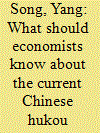

|
|
|
|
|
| Publication |
2014.
|
| Summary/Abstract |
This article explains the current hukou system in China and provides the most recent evidence on the impact of the hukou system on the Chinese labor market and economy. By a comprehensive literature survey, this paper shows that the hukou system plays in two major roles in current China. First, workers with different hukou face different costs of living in cities and have different access to government-provided public services and welfare programs in the urban areas. Migrants with rural and non-local hukou working in the Chinese big cities have no or little access to welfare programs provided by local city governments. Second, there exists labor market discrimination against rural hukou holders in cities, especially in the urban high-wage sector such as state-owned enterprises. The current hukou system has a negative impact on rural-to-urban migration in China as well as on economic efficiency and equality by reducing the expected benefits associated with migration.
|
|
|
|
|
|
|
|
|
|
|
|
|
|
|
|
| 15 |
ID:
133187


|
|
|
|
|
| Publication |
2014.
|
| Summary/Abstract |
This paper analyzes why no foreign direct investment (FDI) has entered basic telecom services in China despite relaxed government policies after the World Trade Organization (WTO) accession in 2001. A new indicator of barriers to FDI incorporating the policy and non-policy impediments has been developed with multiple sources of data including a first-hand survey and interview. Analytic hierarchy process has been applied to reduce arbitrariness in assigning weight to each impeding factor. Results indicate that there is no significant reduction in the actual level of openness to FDI in the sector over the past decade of post-WTO period, which is largely attributable to the recessive non-policy factors. Policy implications are discussed.
|
|
|
|
|
|
|
|
|
|
|
|
|
|
|
|
|
|
|
|
|